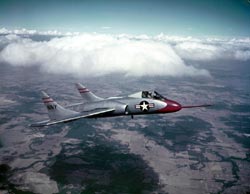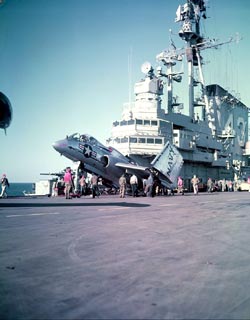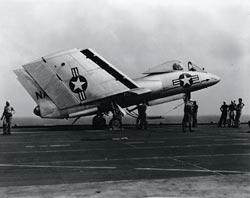|
 The newly designed U.S. Navy fighter F7U-3 was first produced in 1951 with the first flight December 12, 1951. To alleviate the shortcomings of the F7U-1, the airplane incorporated many changes. In addition to basic improvements in performance, visibility, armament, and range, the F7U-3 incorporated many structural, maintenance, and safety improvements. The early production airplanes had Allison J-35 engines without afterburners. These engines were later exchanged for Westinghouse J-46 engines with afterburner. The newly designed U.S. Navy fighter F7U-3 was first produced in 1951 with the first flight December 12, 1951. To alleviate the shortcomings of the F7U-1, the airplane incorporated many changes. In addition to basic improvements in performance, visibility, armament, and range, the F7U-3 incorporated many structural, maintenance, and safety improvements. The early production airplanes had Allison J-35 engines without afterburners. These engines were later exchanged for Westinghouse J-46 engines with afterburner.
 Based on the extensive testing of the XF7U-1 and F7U-1 airplanes, the U. S. Navy awarded Vought a contract for a bigger, faster, Cutlass with more thrust and pilot visibility. The planned powerplant, two Westinghouse J46-WE-8 engines with 6000 pounds thrust and afterburners, was not available for the first 16 airplanes. These first 16 airplanes were powered by two Allison J35-A-29 engines. The radar nose/cockpit design for these 16 airplanes still did not provide sufficient carrier landing visibility. Starting with the seventeenth airplane the radar nose was slanted downward and the cockpit was raised to provide better visibility. The two Westinghouse engines with afterburners, initially installed at that point, were downrated by the Navy to 3,960 pounds military thrust for better engine life. This became the basic configuration for the production F7U-3 airplanes. Based on the extensive testing of the XF7U-1 and F7U-1 airplanes, the U. S. Navy awarded Vought a contract for a bigger, faster, Cutlass with more thrust and pilot visibility. The planned powerplant, two Westinghouse J46-WE-8 engines with 6000 pounds thrust and afterburners, was not available for the first 16 airplanes. These first 16 airplanes were powered by two Allison J35-A-29 engines. The radar nose/cockpit design for these 16 airplanes still did not provide sufficient carrier landing visibility. Starting with the seventeenth airplane the radar nose was slanted downward and the cockpit was raised to provide better visibility. The two Westinghouse engines with afterburners, initially installed at that point, were downrated by the Navy to 3,960 pounds military thrust for better engine life. This became the basic configuration for the production F7U-3 airplanes.
 The armament consisted of four Mk12 20-mm cannons which were mounted in the fairing above the engine duct and fired through ports in the duct lip. Venting changes were necessary early in the program to prevent engine flameout during gunfire. In addition, the F7U-3 carried a removable rocket pack on the belly of the fuselage, containing thirty two 2.75-inch rockets. The armament consisted of four Mk12 20-mm cannons which were mounted in the fairing above the engine duct and fired through ports in the duct lip. Venting changes were necessary early in the program to prevent engine flameout during gunfire. In addition, the F7U-3 carried a removable rocket pack on the belly of the fuselage, containing thirty two 2.75-inch rockets.
The F7U-3 also had a pylon mounted under each inboard wing to which external fuel tanks or an external store up to 2,000 pounds per pylon could be attached. The wing and aircraft ruggedness were such that pilots were known to have pulled 9 g’s in aerodynamic dive pull-ups (without external stores). Substantial maintenance improvement was made in this Cutlass by adding more and larger access doors for replacements and repairs of system components.
More F7U-3:
Engine Story
Production
|